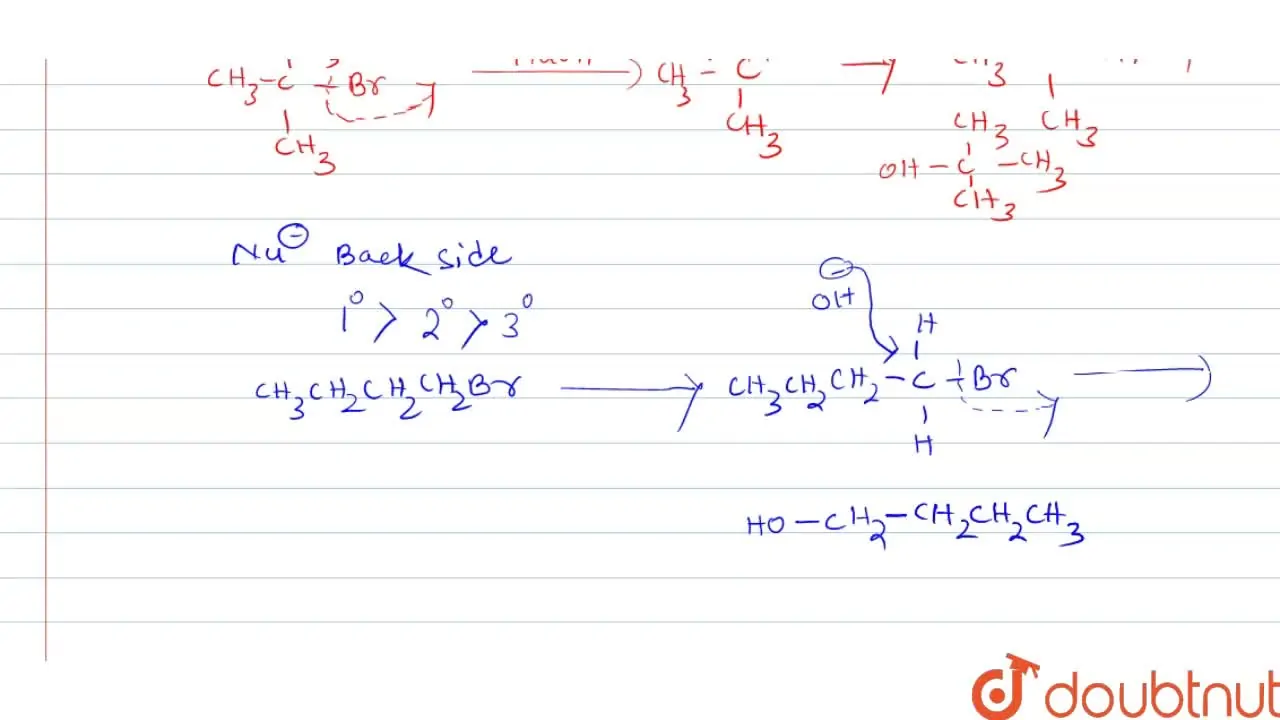Tert-butylbromide reacts with aq. NaOH by SN1 mechanism while n-butylbromide reacts by SN2 mechanism. Why? Solution in Odia
Tert-butylbromide reacts with aq. NaOH as follows :
H3C−CH3∣C∣CH3−BrTert-butylbromide(3∘ alkyl halide)SN1−−→H3C−CH3∣C+∣CH3+Br−3∘ carbocation(more stable)
H3C−CH3∣C+∣CH3+OH−→H3C−CH3∣C∣CH3−OH
tert-butylbromide when treated with aq. NaOH, it forms tert-carbocation which is more stable intermediate. This intermediate is further attacked by OH− ion.
As tert-carbocation is highly stable, so tert-butylbromide follows SN1 mechanism. In case of n-butylbromide, primary carbocation is formed which is least stable, so it does not follows SN1 mechanism.
Here, steric hindrance is very less, so it follows SN2 mechanism. In SN2 mechanism, OH− will attack from backside and a transition state is formed.

The leaving group is then pushed off and the product is formed.
Related Playlists
- BOOK - ARIHANT PUBLICATIONCHAPTER - HALOALKANES (ALKYL HALIDE) EXERCISE - PART-II- QUESTION FOR PRACTICE (SHORT ANSWER TYPE II QUESTIONS)27videos
HALOALKANES (ALKYL HALIDE)
- BOOK - ARIHANT PUBLICATIONCHAPTER - HALOALKANES (ALKYL HALIDE) EXERCISE - PART-II- QUESTION FOR PRACTICE (LONG ANSWER TYPE II QUESTIONS)12videos
HALOALKANES (ALKYL HALIDE)
- BOOK - ARIHANT PUBLICATIONCHAPTER - HALOALKANES (ALKYL HALIDE) EXERCISE - PART-II- QUESTION FOR PRACTICE (VERY SHORT ANSWER TYPE QUESTIONS)9videos
HALOALKANES (ALKYL HALIDE)
- BOOK - ARIHANT PUBLICATIONCHAPTER - GROUP 18 ELEMENTS NOBLEGASES EXERCISE - CHAPTER PRACTICE ( Long Answer Type Questions )6videos
GROUP 18 ELEMENTS NOBLEGASES
- BOOK - ARIHANT PUBLICATIONCHAPTER - PHENOLS EXERCISE - CHAPTER PRACTICE (Long Answer Type Questions )1videos
PHENOLS
Similar Questions
Arrange the following in decreasing order of reactivity towards SN2 reaction (1-Bromopropane,2-Bromo-2-methylpropane ,2-Bromopropane)
03:20View SolutionHow will you bring about the following conversion?
Ethanol to but-1-yne04:57View SolutionWhat happens when ethyl chloride is treated with aqueous KOH?
03:56View SolutionDraw the structural formula of the compound XeF4
03:30View Solution(i) Explain with reason:
(a) Presence of electron withdrawing group increases the acidic character of phenol.
(b) Solubility of alcohols in water decreases with increase in molecular mass.
(c) Phenol is more acidic than ethanol.
(ii) How would you obtain
(a) picric acid from phenol?
(b) 2-methyl propanol from 2-methyl propene?View SolutionWhich of th efollowing alcohols are excepted to react with hydrogen halides by both S_(N)1 and S_(N)2 mechanisms ?
08:21View SolutionSelect whehter the following comination of reactants will reacts by substitions (SN1orSN2 mechanism ) ,eleimation (E1orE2mechanism)
 03:30View Solution
03:30View Solutiontert-Butylbromide reacts with aq. NaOH by S_(N)1 mechanism while n-butylbromide reacts by S_(N)1 mechanism. Why?
05:02View Solutiontert-Butylbromide reacts with aq. NaOH by SN1 mechanism while n butylbromide reacts by SN2 mechanism. Why?
02:50View SolutionAccount for the following: t-butyl chloride reacts with aqueous KOH by SN1 mechanism while n-butyl chloride reacts with SN2 mechanism.
02:43View Solutiontert-Butylbromide reacts with aq.NaOH by SN1 mechanism while n-butylbromide reacts by SN2 mechanism. Why?
07:14View Solutiontert-Butylbromide reacts with aq. NaOH by S_(N)1 mechanism while n butylbromide reacts by S_(N)2 mechanism. Why?
01:49View Solutiontert-Butylbromide reacts with aq. NaOH by S_(N)1 mechanism while n - butylbromide reacts by S_(N)2 mechanism. Why ?
06:35View Solutiontert-Butylbromide reacts with aq. NaOH by SN1 mechanism while n-butylbromide reacts by SN2 mechanism. Why?
07:21View Solutiontert-ब्यूटिलब्रोमाइड जलीय NaOH के साथ SN1 क्रियाविधि से अभिक्रिया करता है, जबकि n-ब्यूटिलब्रोमाइड SN2 क्रियाविधि द्वारा अभिक्रिया करता है। क्यों?
03:53View Solution


